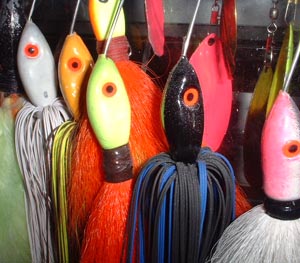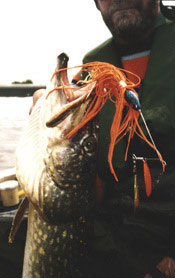 Having
discussed the more technical aspects of spinnerbaits in the first part of this
short series, and hopefully explained how the various design factors affect a
spinnerbait's performance, this time I am going to tell you how to catch pike
on them. Before getting down to the nitty gritty I guess a brief word on tackle
wouldn't go amiss here. Light spinnerbaits, say up to an ounce and a half, can
be fished on just about any tackle. Fixed spool or multiplier outfits are both
fine for spinnerbaiting: Use a braid of thirty to fifty pound test, or mono between
fifteen and twenty. Traces need not be over the top - forty to sixty pound test
multistrand wire is strong and kink resistant enough, fitted out with match-ing
snap links. My preferred outfit is a baitcasting setup, the rod being between
six and a half and seven and a half feet long and intended to cast up to three
ounces or so. The reel is loaded with fifty pound braid. As ever, my reel is an
Ambassadeur of classic design, but adapted with a power handle. These are longer
handles that give you more cranking power. Beachcasters like them for winding
heavy leads back, or small fish in huge balls of weed. I like the power handle
because it makes retrieving large-bladed spinnerbaits much easier. It's good for
fishing large lipped crankbaits too. Maybe a small modification, but it makes
life a lot easier in my experience.
Having
discussed the more technical aspects of spinnerbaits in the first part of this
short series, and hopefully explained how the various design factors affect a
spinnerbait's performance, this time I am going to tell you how to catch pike
on them. Before getting down to the nitty gritty I guess a brief word on tackle
wouldn't go amiss here. Light spinnerbaits, say up to an ounce and a half, can
be fished on just about any tackle. Fixed spool or multiplier outfits are both
fine for spinnerbaiting: Use a braid of thirty to fifty pound test, or mono between
fifteen and twenty. Traces need not be over the top - forty to sixty pound test
multistrand wire is strong and kink resistant enough, fitted out with match-ing
snap links. My preferred outfit is a baitcasting setup, the rod being between
six and a half and seven and a half feet long and intended to cast up to three
ounces or so. The reel is loaded with fifty pound braid. As ever, my reel is an
Ambassadeur of classic design, but adapted with a power handle. These are longer
handles that give you more cranking power. Beachcasters like them for winding
heavy leads back, or small fish in huge balls of weed. I like the power handle
because it makes retrieving large-bladed spinnerbaits much easier. It's good for
fishing large lipped crankbaits too. Maybe a small modification, but it makes
life a lot easier in my experience.
Right
then, you are ready to go. Clip on a spinnerbait and start fishing. Hold it. Have
you selected the right spinnerbait for the situation? If you need to fish deep
then it is best to select a heavy bait (makes sense!) and one with Willow Leaf
blades to get deepest, or Colorados to work it slowly along the bottom with good
control. Think what you are aiming to achieve, presentation wise, and pick a spinnerbait
to fit the bill. Then take a look at the water clarity, or lack of it, and choose
the lure's skirt and blade colours accordingly.
Before
casting out, stop and check the lure. Make sure that the frame is aligned correctly
with the lead head and hook. If the upper arm gets bent out of line this can cause
the lure to run on one side and will stop it coming through weed as cleanly as
possible. A properly tuned frame will also run true. A good starting point for
the frame is to have a right angle between the upper and lower arms, and the lower
arm at roughly forty-five degrees to the shank of the hook. If the spinnerbait
rolls on its side, close up the angle between the arms a little. Altering the
angles of the frame can help you squeeze a little more running depth out of a
lure. Close up the frame, and bend the lower arm down a little and the lure will
fish either deeper or faster depending on how you bring it in. Naturally enough,
the opposite effect can be achieved by opening up the frame.
Ready
to go now? Not quite. Having selected the right lure and tuned it correctly, all
that remains is to sharpen the hooks and start casting! But where and when? Well,
just about anywhere in my experience, and almost any time too! Prime spinnerbait
conditions, though, are in coloured water. I have found both white, and black
and red skirts to score in these conditions, while yellow ones work too. No real
answers as to why this broad spectrum produces, but a consistent factor has been
the presence of fluorescent painted blades.
I
was put on to black and red skirts as being good in coloured water by a customer
of mine, and while he had done well with nickel blades, I gave it a try with fluo
red, and was most impressed. When using coloured blades I like them to match at
least one of the colours in the bait's skirt. Maybe a personal quirk, but it makes
sense to me that the lure should have this visually unifying touch. Of course
my theory falls down in clear water when I like to use reflective blades, but
even here I have a preference for brass blades with skirts that are yellow or
orange based, and nickel blades with everything else.
Back
to the coloured water scenario. With little visibility it is probable, even with
a loud lure, that you will have to get it close to the pike in order to provoke
a positive response. Working the lure slowly will also help the pike target it
more accurately. It therefore makes sense to go for a big fluorescent painted
Colorado blade in these conditions. Just a single blade for maximum vibration.
Select a head weight that will enable you to fish slowly at the depth of water
that the pike are lying in. On a shallow drain, say four feet deep, this might
dictate a head weight of just three quarters of an ounce to get a really slow
retrieve with a number six blade, while a number eight blade might require a two
ounce head to trip bottom in fifteen feet. Trial and error is the only way to
work it all out. If there are snags around start with a light lure rather than
a heavy one and work your way up in weight rather than risk an immediate loss!
 For
fishing in very murky water I prefer a steady retrieve as I reckon this gives
the pike a better chance of homing in on the lure. Of course, this can result
in pike nipping at the lure, or just following it. If you feel a tap on the spinnerbait,
speed the lure up a touch. If this doesn't work, try another cast to exactly the
same spot but fish the entire cast out at a slightly faster rate. I have had fish
bumping spinnerbaits on successive casts before nailing them third time round,
when the speed has been increased sufficiently to either force a more aggressive
take, or has simply pulled the hooks home due to the increase in inertia. There
is no doubt that pike hitting quickly-: fished lures get hooked more easily, which
might explain why increasing the speed of a follow up cast results in hooked pike!
I am not a fan of the often recommended 'sink-and-draw' retrieve for fishing spinnerbaits,
not even in clear water. This regular yo-yoing does nothing for me, and little
for the pike either. However, I do like to 'pulse' a spinnerbait. I keep the lure
moving forwards all the time, without letting the blades stop turning, by speeding
the lure up and slowing it down. The obvious way of doing this to reel quickly
for a few turns of the handle and then slowly for a few. I have to be awkward
and prefer to pulse my spinnerbaits by drawing the rod to one side for a couple
of feet, and then taking up the slack quickly enough to ensure that the spinnerbait
continue on its course. It's a sort of sink-and-draw, but without the sinking
part!
For
fishing in very murky water I prefer a steady retrieve as I reckon this gives
the pike a better chance of homing in on the lure. Of course, this can result
in pike nipping at the lure, or just following it. If you feel a tap on the spinnerbait,
speed the lure up a touch. If this doesn't work, try another cast to exactly the
same spot but fish the entire cast out at a slightly faster rate. I have had fish
bumping spinnerbaits on successive casts before nailing them third time round,
when the speed has been increased sufficiently to either force a more aggressive
take, or has simply pulled the hooks home due to the increase in inertia. There
is no doubt that pike hitting quickly-: fished lures get hooked more easily, which
might explain why increasing the speed of a follow up cast results in hooked pike!
I am not a fan of the often recommended 'sink-and-draw' retrieve for fishing spinnerbaits,
not even in clear water. This regular yo-yoing does nothing for me, and little
for the pike either. However, I do like to 'pulse' a spinnerbait. I keep the lure
moving forwards all the time, without letting the blades stop turning, by speeding
the lure up and slowing it down. The obvious way of doing this to reel quickly
for a few turns of the handle and then slowly for a few. I have to be awkward
and prefer to pulse my spinnerbaits by drawing the rod to one side for a couple
of feet, and then taking up the slack quickly enough to ensure that the spinnerbait
continue on its course. It's a sort of sink-and-draw, but without the sinking
part!
Of course, breaking
up a steady retrieve with an occasional fluttering turn of the bait does no harm
all. In fact this tactic can a great trigger, as can a sudden burst of speed thrown
into the retrieve. Bringing a spinnerbait steadily past a pike-holding spot might
not do much to elicit a response. On the other hand ripping it as it passes a
pike lying in wait can result in a lightning strike. It's the equivalent to twitching
a minnowbait I think. The speeding-up trick can work on unseen followers too,
but of course you never know if they are there unless you get a take!
When
working a spinnerbait steadily down a slope following the contours (when fishing
from a boat, or casting to the far bank of a river or drain), an extra turn of
speed will pull the lure out from the bank and might just get you a take. If it
doesn't, then let the spinnerbait drop on a tight line as this pause might
do the trick. I have found that takes on the drop, from the time a spinnerbait
hits the water until you start the retrieve, come mostly when casting to vertical
structures that pike are lying close to. This kind of feature holds pike on a
regular basis. I am thinking primarily of things like iron pilings and brick walls
on venues like rivers, drains and canals, but features like this exist on stillwaters
too. If the spinnerbait seems to be taking a long time to hit the bottom, it's
been grabbed. Strike! Keep in contact with the spinnerbait at all times so that
you feel the blades stop spinning straight away.
Whenever
a spinnerbait goes dead, wind like fury and strike when you feel resistance, even
if it is not a pike. Don't waste time and effort striking on a slack line though,
always make sure there is something hanging on, even if it is only weed. At least
the strike might break the weed free of the lure and allow the retrieve to continue
effectively without the blades being fouled up.
There
are times when pike want lures fished fast (indeed speed can be the trigger during
the warmer months) and, although the in-line bucktail spinner is the easiest to
use, I have never done particularly well on these lures. Spinnerbaits have been
another matter. Pick out a lightish one, an ounce head, say, rigged with either
a single willow leaf blade or tandem fluted blades. Chuck it out and zip it back.
Fancasting shallow water in spring and early summer with quickly-retrieved spinnerbaits
can be highly productive, fished over or through sparse weed growth. Make sure
that the bend of the hook reaches the end of the skirt, as pike have a tendency
to nip at quickly-fished lures of all types.
When
casting spinnerbaits in shallow water it is essential to get the lure going as
soon as it splashes down, especially with weed reaching up from the bottom. This
is most easily done with a multiplier reel, by thumbing the spool before the lure
hits the water and engaging the gears at the same time. Almost start winding in
before the lure gets wet!
Spinnerbaits
can also be used to search out large areas of water when afloat by trolling. Large
shallow bays such as those found on Irish loughs, can be effectively trolled with
spinnerbaits, and they work at pretty high speeds too - certainly around three
miles per hour. Big flashy blades work well in lcear water and help keep the baits
up above the weed tops. My skirt choice in clear water is either white or red
and black, but I am sure other subdued or natural looking colours would work well.
No doubt copper blades will score too, but they give me a terrible lack of confidence,
so I shy away from them.
For
trolling I like to use as a big a skirt as I can on my spinnerbaits to give pike
a large target to home in on, and big blades also help to attract their attention
from a distance.
When trolling
deeper water with spinnerbaits don't forget that the blades give them lift, so
to fish deep with big vibratory blades you will need heavy heads. Two and a half
ounces is sometimes not enough, and spinnerbaits can be weighted with lead folded
or wrapped around the frame just in front of the head. If you are holding the
rod, pump it forward now and then and allow the lure to fall back on a tight line,
and always keep alert for slack line takes. Striking these on the troll is a bit
of a gamble, and you are probably best off doing nothing and waiting for the boat
to take up the slack. Trust in the Lord to make the pike keep a hold on the lure!
If the rod is in a rest keep an eye on the tip for any change in rhythm, as a
spinnerbait that is fouled with weed is not working to its best advantage. You
will also see slack liners indicated by the tip springing back, hopefully slamming
down to the water a second or two later with the rod bucking wildly!
Spinnerbaits
are not just stillwater lures, they are equally devastating in rivers where they
can be fished upstream, down-stream or even across the flow. Bear in mind the
effect that the flow will have on the blades and that it will increase the lift
when casting downstream, and reduce the turning effect on the blades when casting
upstream. Upstream casts mean that you have to bring the spinnerbait in more quickly,
but don't think that this will be a less effective presentation.
It
might be harder to maintain contact with the lure, and to keep those blades spinning,
but the lure will be coming in deep and straight into the pike's field of vision.
When casting across slack water into the main flow you will lose contact with
the lure for a second as it enters the slack and the blades stall. Give the lure
a burst of speed to get them turning again and hang on for a take.
I
have caught pike on spinnerbaits in just about every month of the year, in all
sorts of conditions and from many water types, still and running. Which just about
sums up spinnerbaits as the all-round lure. I doubt very much that there is a
water where they won't catch pike. Don't leave home without one or two........
dozen!
(This
article first appeared in Pike and Predators issue 13)

